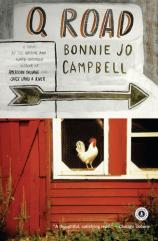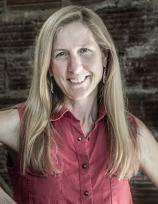Reading Group Guide
Discussion Questions
Q Road: A Novel

1.Campbell begins and ends her book with depictions of woolly bears. What do these orange-and-black caterpillars symbolize? What other symbols or metaphors recur throughout Q Road?
2. In addition to the three central personalities (Rachel, George, and David), Q Road has quite a few supporting characters. How does the story benefit from Elaine Shore's alien fixation or Johnny Harland's swaggering confidence? What do you learn about Greenland Township through Mary O'Kearsy or Milton Taylor? Why do you suppose the author created such a sprawling cast?
3. In chapter 20, Elaine Shore's lawyer dubs her a "pioneer" for her attempts to bring "civilization" to Q Road. What compels people like Elaine and the Hoekstras to move to rural areas? How do you explain their reaction to the unexpected "disorder" of their rural neighborhood? Analyze the omniscient narrator's tone in chapter 20 and at other points in the novel that address the development of former farmland.
4. Rachel is an unconventional, abrasive young woman. Is it still possible to identify or sympathize with her? Why or why not? How and why has she come to love George Harland's land so much?
5. In chapter 3, Margo says to Rachel, "I thought I could raise a girl to be something on her own, but you act no better than a creature clawing its way up the riverbank to get caught in somebody's trap" (25). How does Margo contribute to what happens that night between Rachel and Johnny? Why does Margo shoot Johnny? What do you think happens to Margo after she kills him?
6. When Margo shoots Johnny in chapter 3, she also shoots a chicken, a detail the author highlights in a darkly comic way. Where else in Q Road does Campbell contrast tragedy and comedy? What purpose does such a literary device serve?
7. David feels closer to Rachel and George than he does to his parents. Trace the origin of his feelings. Discuss the ideas of parenthood and family as they are depicted in Q Road.
8. What clues in the first half of the novel alert you to the fact that something disastrous is about to happen? Were you able to predict what the impending disaster would be?
9. Review pages 127 and 128, where David drops his cigarette in the barn, then finds it again. What were you thinking during this scene? At the end of chapter 17, did you think David was dead? What was your reaction when you found he had survived the fire? How do his several near-death experiences fit into the story?
10. Considering the couples in Q Road -- Rachel and Johnny, Rachel and George, Nicole and Steve, Old Harold and Henrietta, April May and Larry -- which seems healthiest? Compare Rachel's and George's reasons for marrying to the other couples' motivations. Are Rachel and George more or less opportunistic, more or less honest than the other characters?
11. Read the passage on page 123 beginning with the description of Sally's bedroom. How does the author's characterization of Sally reinforce and/or confound our cultural stereotypes of the poor? Compare Sally to other poor characters in the novel. How are the poor in Q Road similar to or different from the poor in other contemporary fiction? How would you characterize the omniscient narrator's attitude toward poverty?
12. The events of Q Road take place on October 9, 1999, but are interspersed with the history of the people who have lived in the vicinity for centuries. What impact does the historical material have on the present action of the novel? Explore the importance of history to selected characters. How do the ancestral stories told by characters such as Old Harold and Margo change as they are handed down to the next generation? Why does Rachel cling to her story of the Potawatomi Corn Girl?
13. Discuss the scene in chapter 36 in which Steve Hoekstra discovers Nicole stabbing a pumpkin on the deck of their prefabricated home. How might Steve and Nicole's life together be different from this point forward?
14. Birds of many species populate Q Road -- chickens, crows, chickadees, and turkey vultures, to name a few. Compare Officer Parks's seagull observations on page 87 with April May's musings about English sparrows on page 100. How do these passages resonate with the themes of the novel? Why do you suppose Steve Hoekstra drives a Thunderbird? What purpose does chapter 14 -- the description of Gray Cat hunting -- serve within the larger scheme of the novel?
15. On page 117, Old Harold tells George that Mary O'Kearsy "was as beautiful as the day is long." On page 232, Tom Parks uses the same expression to describe Margo Crane. Why do you suppose the author linked the two women (or these two men) in this manner?
16. Many of the characters in Q Road imagine that nature avenges human wrongdoing. What is the purpose of personifying nature in this way? Compare Harold's view of the 1934 tornado on pages 200-206 with Henrietta's perspective on pages 219-20. Explain how and why they see the same events so differently.
17. While Q Road is a novel about community, it is also about the difficulties of human connection. Consider the causes and effects of loneliness and isolation for Rachel, Margo, George, David, Nicole, and Officer Parks.
18. Read the passage on pages 31-32 that begins "When the cattle had busted down the fence a few days ago, George wasn't around" and ends "The bedsprings were an announcement to the world that farming was no longer a sensible way of making a living..." What motivates George and other farmers to continue to farm when they have to struggle so desperately to survive?
19.Why do you think the pain in April May's foot disappears after the barn burns down?
20. Henrietta Harland and Rachel Crane are both gifted gardeners, able to sense the coming of the first hard frost in time to protect their yield. Are Henrietta and Rachel alike in other ways? How are they different?
21. What do you think of Rachel's reaction to David when she finds him standing outside the house after the fire?
22. Tom Parks describes Sally as "an element of nature" on page 263. Does this comparison surprise you? What is fitting about it?
23. April May believes that Greenland farmers and the new residents in the prefab houses can get along "if only everyone would be sensible and tolerant" (174). She muses that a natural disaster like the tornado of 1934 might rally Greenland to a common cause "the way God used to" (175). Does the barn fire have this effect on the residents of Q Road? What would you say the future holds for Q Road?
Q Road: A Novel
- Publication Date: August 19, 2003
- Paperback: 288 pages
- Publisher: Scribner
- ISBN-10: 0743203666
- ISBN-13: 9780743203661








